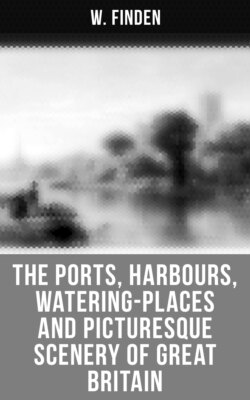Читать книгу The Ports, Harbours, Watering-places and Picturesque Scenery of Great Britain - W. Finden - Страница 26
На сайте Литреса книга снята с продажи.
CULLERCOATS.
ОглавлениеTable of Contents
In the Engraving is given a view of Cullercoats, as seen from the southward. On the sand, in the foreground, is a coble, a light kind of boat, generally employed by the fishermen on the coast of Northumberland; near the coble, to the right, is a dand or buoy, used by the fishermen to mark the place where they have cast their lines or nets. It is formed of an inflated bag of tanned skin, through which a light pole passes, and to which pole the ends forming the openings of the bag are tightly tied with cord. The lower end of the pole is sometimes rendered heavy by lead, so that the dand may float upright, and it has also a loop, or a ring, to which the rope connecting it with the nets or lines is fastened; and a piece of bunting, or coloured cloth, is attached, as a small flag, to the upper end, in order that it may be more perceptible at a distance.
The village of Cullercoats, which lies about a mile to the northward of Tynemouth, is mostly inhabited by fishermen. The duties performed by the wives and daughters of the Cullercoats fishermen are very laborious. They search for the bait—sometimes digging sand-worms in the muddy sand at the mouth of the Coble-dean, at the head of North Shields; gathering muscles on the Scalp, near Clifford's Fort; or seeking limpets and dog-crabs among the rocks near Tynemouth;—and they also assist in baiting the hooks. They carry the fish which are caught in North Shields in large wicker baskets, called creels, and they also sit in the market there to sell them. When fish are scarce, they not unfrequently carry a load on their shoulders, weighing between three or four stone, to Newcastle, which is about ten miles distant from Cullercoats, in the hope of meeting with a better market. The fish principally caught by the fishermen of Cullercoats are codlings, cod, ling, (Gadus molva), halibut, usually called turbot in Northumberland, haddocks, and whitings. Herrings are also taken in the season; and the colesay (Gadus carbonarius), is occasionally caught, but it is a fish which is hardly worth the bait, as it is scarcely saleable at any price. The most valuable sea-fish caught by the fishermen of Cullercoats, is the bret, or turbot of the London market. But this fish, when caught by them, is mostly sold to the bret smacks, by which it is conveyed to London. Gentlemen residing at Cullercoats or Tynemouth during the bathing season, may often obtain excellent sport in fishing for whitings, in fine weather, off the north-eastern end of the Herd Sand. The best time is in the evening, towards high-water; and the best bait is sprats cut into small pieces; it is no extraordinary feat for a party of three, with half a dozen lines, to take twelve or fifteen dozen of whitings in three hours, on a summer's evening.
For the amateur sea-fisher, in the neighbourhood of Tynemouth, there is no bait generally so good when fishing within six or eight miles of the shore, as the small dog-crab, called in the neighbourhood of Shields a pillan. It is known from the common dog-crab by the facility with which its shell may be stripped off; for instance, in breaking the shell round one of its claws, the broken portion may be withdrawn from the member as a glove from the hand; and the shell of the back may also be stripped off in the same manner. From this facility of peeling, it is probable that the crab derives its local name of pillan. Pillan, however, are not plentiful; and when such are not to be got, then sand-worms, muscles, and common dog-crabs are the most likely bait. Codlings and rock-codlings are plentiful a little to the eastward of Tynemouth; but, haddocks and cod, the staple of the Cullercoats fishermen, are not often caught in any great quantity within seven miles of the shore. The young of the colesay, called a hallan, a beautiful little fish, is frequently caught with a rod, from the rocks in the neighbourhood of Tynemouth. The weaver, (Trachinus draco,) or stinging-fish as it is called at Shields, is often caught when fishing off Tynemouth Bar; and strangers, who are unacquainted with the formidable character of this little fish, are sometimes pricked by it when taking it off the hook. The men who are employed in the salmon fishery, at the end of the Herd Sand, have sometimes their bare feet stung by it when hauling their nets. The average length of this fish, as caught at the mouth of the Tyne, is about five inches; though some are occasionally caught there three or four inches longer. The dangerous spines are those of the first dorsal fin; and the best remedy for the wound is to rub it well with sweet oil.
Cullercoats is a kind of land-mark for vessels leaving Shields Harbour; for as soon as the man at the helm can see the village opening behind Tynemouth Cliff, the ship is over the bar.
DUNSTANBOROUGH CASTLE. FROM THE EASTWARD.
